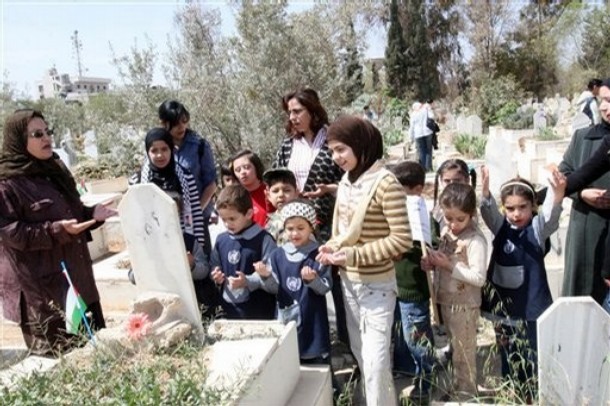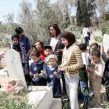
Growth of Salafist Militancy in Palestinian Refugee Camps Poses Security Risks
Publication: Terrorism Monitor Volume: 7 Issue: 32
By:

U.N. Interim Force in Lebanon (UNIFIL) Force Commander Major General Claudio Graziano recently told Al-Safir newspaper that small groups of terrorists from Palestinian camps continue to represent a threat to security in southern Lebanon. Graziano said that the international peacekeepers were taking precautions against any extremist threats and were cooperating with the Lebanese Armed Forces (LAF) to ward off any attack. "There is limited information on the networks, and it is very difficult to identify them," he said, adding that UNIFIL does not take the threats lightly. "We even consider the threat a terrorist activity, because it encourages carrying out such operations" (Al-Safir [Beirut], September 26).
The statements of Graziano paralleled reports suggesting that the Islamist militant group Fatah al-Islam is trying to infiltrate and operate in several Palestinian refugee camps in Lebanon. The reports claim that camps targeted by the militants include the al-Biddawi camp in the north and the al-Burj al-Shamali camp in the south. This information reinforces suspicions that Fatah al-Islam members are trying to form small cells that can be employed in future terrorist attacks. (Al-Ra’y [Kuwait Daily], September 22).
Background
These reports serve to indicate the increasing inclination towards the Salafi-Jihadi ideology and the growing radicalization of young Palestinians in the refugee camps in Lebanon as well as in Jordan and Syria. Socio-political conditions in these camps, which have been under the control of the secular Palestinian political organizations, play an important role in increasing the influence of Salafism. Conditions promoting this growth include the absence of any prospect of resolving the Arab-Israeli Conflict, rising poverty and unemployment, the political ramifications of the Fatah-Hamas conflict, and the deterioration of the Palestinian Liberation Organization (PLO) and its control over the refugee camps.
The Salafi-Jihadi ideology in the refugee camps has come in three phases:
• The first phase was the introduction of the ideology in the mid-1980s. The establishment of the Salafist militant group ‘Usbat al-Ansar (League of Partisans) in the Ayn al-Hilwa refugee camp in southern Lebanon was typical of this phase. This period also witnessed the emergence of nationalist groups using Islamic slogans and the establishment of Hamas and Islamic Jihad.
• The second phase occurred when the Salafi-Jihadis started playing a larger role in hosting and training non-Palestinian jihadis. The 2003 bombing of a McDonalds and several other Western restaurants in Lebanon by Yemeni Muammar Abdullah al-Awami (a.k.a. Ibn al-Shahid) was an example of this development. Al-Awami prepared for the attack in the Ayn al-Hilwa refugee camp and later returned there to hide from security forces.
• The third phase is the emergence of the Salafi-Jihadi ideology as the primary ideology for Palestinian youth in the camps. This phase is occurring now, as individuals and small groups are increasingly turning to Salafist militancy.
The Camps in Jordan, Syria and Lebanon
In Lebanon, for instance, there are 21 “official” refugee camps and the number of Palestinians living in these camps is a highly sensitive issue in a country where the political “sectarian balance” is at the core of the state. Those who live in these official camps represent about 10.5% of Palestinian refugees worldwide, while a further 20% live in 13 “unregistered” camps run by the United Nations Relief and Works Agency (UNRWA). In Lebanon there are 81 careers forbidden to Palestinians, with the socio-political situation playing a pivotal role in the growth of Salafist inclinations amongst Palestinian youth. According to analyst Omayma Abdel-Latif, the Palestinian camps are “fertile ground for radical Salafist groups” in the absence of official Lebanese control over the camps. [1] The 1969 Cairo Agreement gave the PLO administrative control of the refugee camps and the freedom to conduct military activities in southern Lebanon. Though the Lebanese government (with the encouragement of Syria) abrogated the Cairo agreement in 1987, the PLO conducts itself as if the agreement is still in force and government forces have been reluctant to assume direct control of the camps.
Ayn al-Hilwa has been the breeding ground for a number of leading jihadis in recent years. Abu Muhjin (a.k.a. Ahmad Abd al-Karim al-Sa’adi), the former leader of ‘Usbat al-Ansar and brother of current ‘Usbat al-Ansar leader Abu Tariq (a.k.a. Haytham Abd al-Karim al-Sa’adi) was reported to be one of Abu Musab al-Zarqawi’s deputies in al-Qaeda in Iraq. Another Palestinian from Ayn al-Hilwa, Salih al-Qiblawi, appeared in al-Zarqawi’s 2006 video and was reported by a militant Salafi ideologue to be responsible for a missile attack on north Israel in 2002 (see Terrorism Monitor, March 26). Further north, the Fatah al-Islam group which clashed with the Lebanese army at the Nahr al-Barid camp in 2007 is yet another example of the “jihadization” occurring in Palestinian refugee camps in Lebanon.
In Syria, there are nine refugee camps with a population of about 457,000, according to the UNRWA. The biggest refugee camp in Syria, al-Yarmouk, experienced clashes between militants and Syrian security forces last year (al-Hayat, October 10, 2008). When Syria became a transit point for Syrian and Arab fighters aiming to take up jihad against Americans between 2003 and 2007, there were several cases of young fighters passing through al-Yarmouk camp.
In Jordan, 19-year-old Tha’ir al-Wahidi, from Baqa’a camp, shot four Lebanese members of the Kaslik choir in 2008 in the capital city of Amman and then shot himself and died in the hospital (ammannet.net Radio, July 22, 2008). Baqa’a camp is the largest Palestinian refugee camp in Jordan. On September 2, a Jordanian court launched the trial of three people (one still a fugitive) accused of planning to attack the Jordanian intelligence service office in Baqa’a (al-Ghad, September 2). Arrests after the Tha’ir al-Wahidi incident revealed the presence of the Salafi-Jihadi ideology in the Baqa’a camp. The trial also revealed that the group that recruited Tha’ir al-Wahidi consists of 12 members, all of whom are of Palestinian origin. The alleged leader of the group is Shaker Umar al-Khatib, who is originally from the Gaza Strip and now a resident of Irbid camp, north of the Jordanian capital of Amman (Al-Hayat, January 28).
Irbid camp is mentioned repeatedly when Salafi- Jihadi issues are raised. Irbid, being close to the Jordanian-Syrian border, emerged as a transit point for Salafi-Jihadis heading to Iraq or to Lebanon in the last few years (al-Hayat, June 29). Salafi-Jihadi movements in Jordan in the mid 1990’s were associated with cities like Zarqa, Salt and Maan. Convicted persons in such cases, since the mid 1990’s, were Jordanians of Palestinian origin. Most of them were residents of East Amman, Zarqa or the city of Irbid and not residents of the camps (al-Hayat, June 29).
Al-Wahidi and al-Khatib were not the only Salafi-Jihadi leaders who came from the refugee camps in Jordan. The number of Palestinian refugees in the camps in Jordan, according to UNRWA estimates, is around 1,930,000. [2] Among the local leaders of the Salafi-Jihadi movement is Jihad al-Qasheh, originally from Irbid camp, and Sulayman Ghayyad al-Anjadi, killed by the Jordanian authorities after an armed confrontation in 2007. Al-Anjadi was accused of attempting to help Azmi al-Jayousi escape from prison with the help of other persons and was also accused of planning to assassinate U.S. President George W. Bush during his visit to Jordan in 2006.
The ties between the Salafi-Jihadis across the Levant region show that some young men in the refugee camps are inspired and influenced by the late Abu Musab al-Zarqawi’s ambition of creating a Levantine Salafi-Jihadi movement. The latter was started in Zarqawi’s Afghan training camp in 2000 before al-Zarqawi moved to Iraq and led al-Qaeda forces there until he was killed in June 2006.
Conclusion
The impasse that the Middle East peace process is currently experiencing in addition to the decline of the secular Palestinian organizations in the refugee camps has put Salafi-Jihadism in a position to become increasingly attractive to Palestinians in the refugee camps. There is also a growing focus in Salafi-Jihadi web statements on the Gaza Strip since the August clashes between Hamas and the Salafist Jund Ansar Allah faction that led to the death of Jund Ansar Allah founder Abu Nur al-Maqdisi (a.k.a. Dr. Abdul Latif bin Khalid al-Mousa).
Al-Qaeda leader Osama bin Laden has devoted several speeches to the Palestinian issue (three of six statements issued so far this year were dedicated to the matter); in March 2008 he issued a speech entitled "The Way for the Salvation of Palestine" in which he urged Palestinians to take up jihad in Iraq before liberating Palestine:
My Islamic nation! You know that the nearest field of jihad today to support our people in Palestine is the Iraqi field, so it is necessary to be concerned with it, focus on it, and support it. The duty of providing support is most urgently needed from Muslims living in neighboring countries. It is necessary for all the people of the Levant, the people of that blessed land to recognize the power which Allah has bestowed upon them, and to support their mujahideen brothers in Iraq as they are obliged to do. It is a great opportunity and a great duty upon the arriving emigrant brothers from Palestine – who were prevented from waging jihad on the hills of Jerusalem – to shake off the illusions of political parties and other groups which are immersed in deception of the democracy. And they should hasten to take their positions among the ranks of the mujahideen in Iraq, and through support and trust in Allah…he will aid them by his will. Then, there shall be a move towards the blessed al-Aqsa [mosque in Jerusalem] and then the mujahideen coming from outside shall encounter their brothers within – and this moment will remind us of the legacy of Hittin [where Muslim leader Salah al-Din defeated the Crusaders in 1187], and the Muslims shall delight in their clear victory. [3]
Jihadi web forums such as alflojaweb.com, hanein.info and muslm.net have devoted special sections to al-Maqdisi and his criticism of Hamas for being too liberal. The spread of such materials can be expected to play a role in reshaping the thinking of young Palestinians in the refugee camps as they come under their influence. If training and organization become available to these young people they have the potential to become a threat to not only the countries in which they reside, but to the region as a whole.
Notes:
1. Omayma Abdel-Latif, Lebanon’s Sunni Islamists: A Growing Force,
Carnegie Endowment, Carnegie Paper, January 2008, https://www.carnegieendowment.org/publications/index.cfm?fa=view&id=19882.
2. https://www.un.org/unrwa/arabic/Refugees/index1.htm
3. Al-Sahab Media, March 21, 2008. For full translation, see, https://www.nefafoundation.org/miscellaneous/nefabinladen0308-2.pdf.





